Long SS, Surrey DE, Nazarian LN. American Journal of Roentgenology. 2013;201(5):1083-1086.
Abstracted by: Samuel Hampton, SPT, Springfield, Missouri
This retrospective case review of sonographic examinations examined and calculated the prevalence of trochanteric bursitis, gluteal tendon abnormalities, and iliotibial band abnormalities in 877 individuals – 602 women and 275 men, with an average age of 54 years- at a single institution over a 6-year period.
The two radiologists performed a systematic review of their department of radiology database. Their inclusion criteria was: Dated between January 1, 2005 to December 31, 2010, key words of “Greater trochanteric,” “Trochanteric,” “Gluteus Medius,” and “gluteus Minimus”. The radiologists adhered to the following exclusion criteria: Examination not pertaining to the greater trochanteric region, repeated examination of the same patient, hip arthroplasty patients, and patients without complaint of greater trochanter pain or tenderness as determined by provided clinical history or palpation.
The actual imaging was performed by any one of six sonographers, utilizing either a 12MHz linear probe on most patients or a 9MHz linear probe on larger patients. Findings reported by these six radiologists, as per their dictated reports, were the basis for this analysis. Trochanteric bursitis was defined by hyperechoic fluid imaging of the bursal sac. Gluteus medius and minimus tendinopathy were defined by thickening of the tendon and loss of fibrillary pattern. Tears were defined by full or partial disruptions in the fibrillary pattern of the tendon which may be fluid filled or depicted by decreased tendon mass. Iliotibial band thickening was defined by enlargement of the band at the level of the greater trochanter. The prevalence of findings by age or sex were analyzed by either a Chi-squared or student t-test, with a significance level of p<0.05.
A large majority, 700(79.8%), of the 877 patients reviewed did not have any form of bursitis. Four hundred and thirty eight (49.9%) patients had gluteal tendinosis; 236 (52.5%) were isolated gluteus medius tendinosis. One hundred and seventy seven patients (20.2%) did have greater trochanteric bursitis. As far as the iliotibial band, 622 (70.9%) of the patients had typical presentation, while 250 (28.5%) presented with thickening and 5 showed a partial tear. Of those with bursitis, only 8.1% of patients reviewed were found to have bursitis as an isolated finding and a large majority of those with bursal involvement were women.
Personal Commentary
As the authors noted, there are several limits to this study: The sonographic images were not reexamined at the time of the study and only the initial interpretation was integrated into the analysis. There was also the possibility of referral bias leading to decreased external validity. Lastly, there were no other methods of confirming the diagnoses and the authors relied solely upon the accuracy of diagnostic ultrasound.
While no other methods of confirmation were utilized, recent literatures review by Henderson, Walker, and Young, described diagnostic ultrasound as having a moderate-to-high accuracy for diagnosing gluteal tendinopathy, as well as a moderate diagnostic value for ruling out trochanteric bursitis and high value for ruling trochanteric bursitis in. With only a moderate ability for ultrasound to rule out non-bursitis cases, there could potentially be an increased number of inaccurate bursitis diagnoses being included. Given the findings of this review, granted that they are externally valid, the question arises of: Are we as clinicians over emphasizing the bursae?
In opposition to the findings of this review, the International Academy of Orthopedic Medicine’s Diagnosis-specific orthopedic management of the hip book states, “Deep pressure can be effectively used to localize the most painful spot [of the lateral aspect of the hip], and in most instances, this will be the location of the bursae.” Additionally, in subsequent sections, the lesion is described as difficult to differentiate from pain due to an insertional tendinopathy. Fortunately, the book does describe one means of differentiating trochanteric bursitis from a tendinopathy: Decreased tenderness with resisted isometric contraction of the hip abductors and internal rotators with the hip in flexion, abduction, and internal rotation while the patient is positioned side-lying on non-painful side, although sensitivity and specificity was not noted. There is also a special test described in a 2013 article by Reiman, Mather, and Cook for gluteal tendinopathy called the resisted external de-rotation test, which has a specificity of 97.3% and a sensitivity of 88%. In this test, the patient is supine with hip and knee flexed to 90 degrees with external rotation. The patient then actively returns the leg, against resistance, to neutral while maintaining hip and knee flexion.
References
- Henderson REA, Walker BF, Young KJ. The accuracy of diagnostic ultrasound imaging for musculoskeletal soft tissue pathology of the extremities: a comprehensive review of the literature. Chiropractic & Manual Therapies Chiropr Man Therap. 2015;23(1). doi:10.1186/s12998-015-0076-5.
- Long SS, Surrey DE, Nazarian LN. Sonography of Greater Trochanteric Pain Syndrome and the Rarity of Primary Bursitis. American Journal of Roentgenology. 2013;201(5):1083-1086. doi:10.2214/ajr.12.10038.
- Phelps V, Sizer PSJ, Brismée Jean-Michel, VanParidon D, Matthijs O. Diagnosis-Specifc Orthopedic Management of the Hip /Phillip S. Sizer Jr., Valerie Phelps, Jean-Michel Brismée, Didi VanParidon, Omer Matthijs. Minneapolis, MN: International Academy of Orthopedic Medicine -US; 2011. Pages 42, 89-90
- Reiman MP, Mather RC, Cook CE. Physical examination tests for hip dysfunction and injury. British Journal of Sports Medicine Br J Sports Med. 2015;49(6):357-361. doi:10.1136/bjsports-2012-091929.

